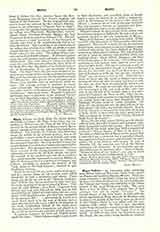

Mayo Indians .—An important tribe occupying some fifteen towns on Mayo and Fuerte rivers, southern Sonora and northern Sinaloa, Mexico. Their language is known as the Cahita, being the same as that spoken, with dialectic differences, by their neighbors, the Tehueco and Yaqui, and belonging to the Piman branch of the great Shoshonean stock. The name Mayo is said by Ribas to be properly that of their principal river and to signify “boundary”. The known history of the tribe begins in 1532 with the naval expedition of Diego Hurtado de Mendoza, who landing at the mouth of the Fuerte, went up the river to the villages, where he was killed with his companions while asleep. In 1533 a land expedition under Diego de Guzman crossed through their country and penetrated to beyond the Yaqui river in the north. In 1609-10 they aided the Spaniards against the Yaqui, the two tribes being hereditary enemies, and on the suppression of the revolt it was made a condition of the agreement that the Yaqui should live at peace with the Mayo. In 1613, at their own request, the first mission was established in their territory by the Jesuit Father Pedro Mendez, who had visited them some years before, over 3000 persons receiving baptism within fifteen days, in a population variously estimated at from nine to twenty thousand. Within a short time seven mission churches were built in as many towns of the tribe. This was the beginning of regular mission work in Sonora.
In 1740 the Mayo, hitherto friendly as a tribe, joined the Yaqui in revolt, apparently at the instance of Spanish officials jealous of missionary influence. The churches were burned, priests and settlers driven out of the country; and although the rising was put down in the following year after hard fighting, it marked the beginning of the decline of the missions which culminated in the expulsion of the Jesuits in 1767. After their departure the Indians were for some time without religious teachers, but are now served by secular priests. In 1825-7 they again joined the Yaqui, led by the famous Bandera (Juzucanea) in revolt against Mexican aggression, and have several times since taken occasion to show their sympathy with their fighting kinsmen. The Mayo are sedentary and industrious farmers and mine laborers, and skillful artisans in the towns. They cultivate corn, squashes, beans, tobacco, cotton, and maguey, from which last they distill the mescal intoxicant. Their houses are light structures of cane and poles, thatched with palm leaves. They are all Catholic and very much Mexicanized, though they retain their language, and have many of the old Indian ideas still latent in them. Their principal town is Santa Cruz de Mayo, and they are variously estimated at from 7000 to 10,000 souls. The most important study of the language, the Cahita, is a grammar (Arte), by an anonymous Jesuit published in Mexico in 1737.
JAMES MOONEY

